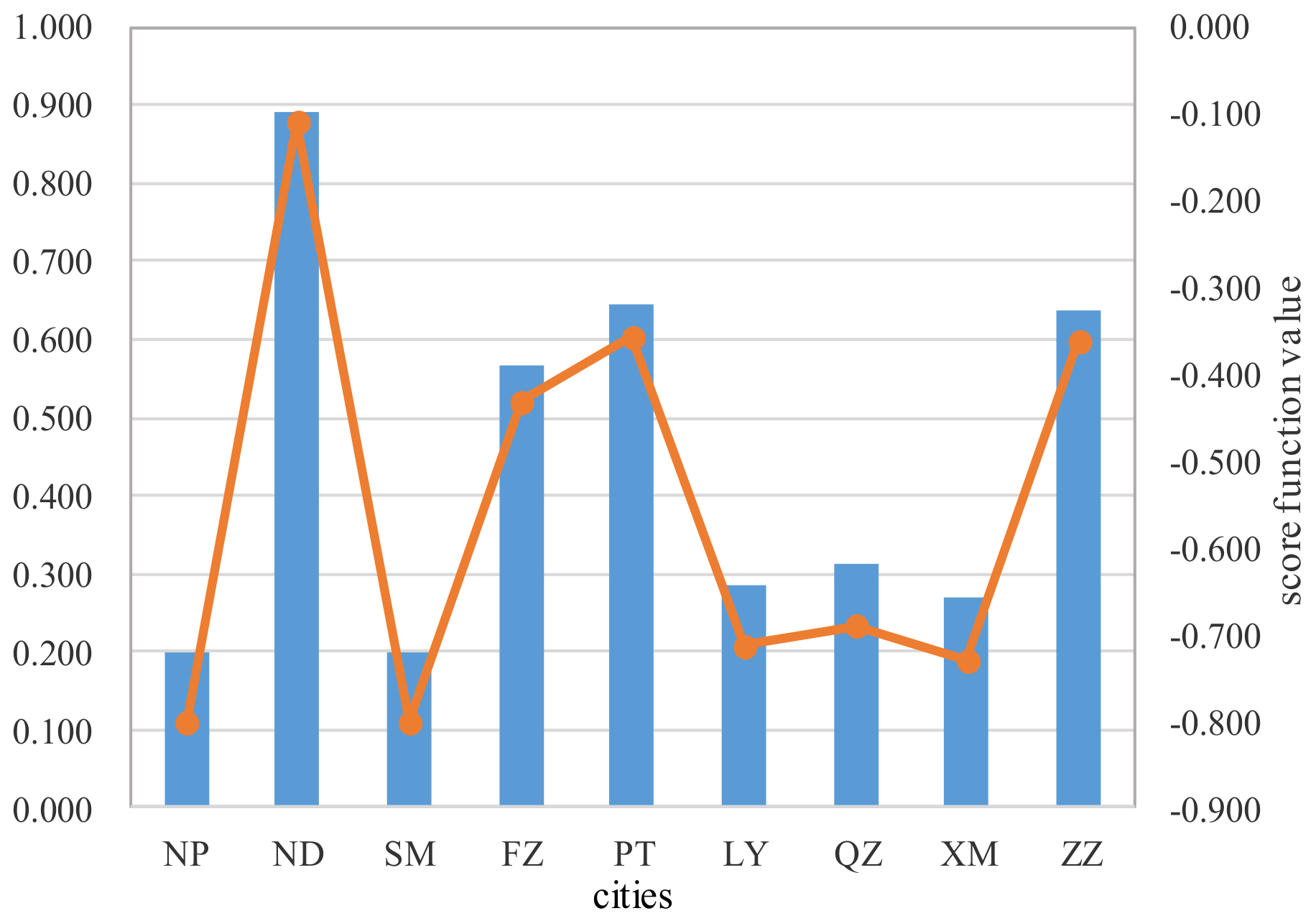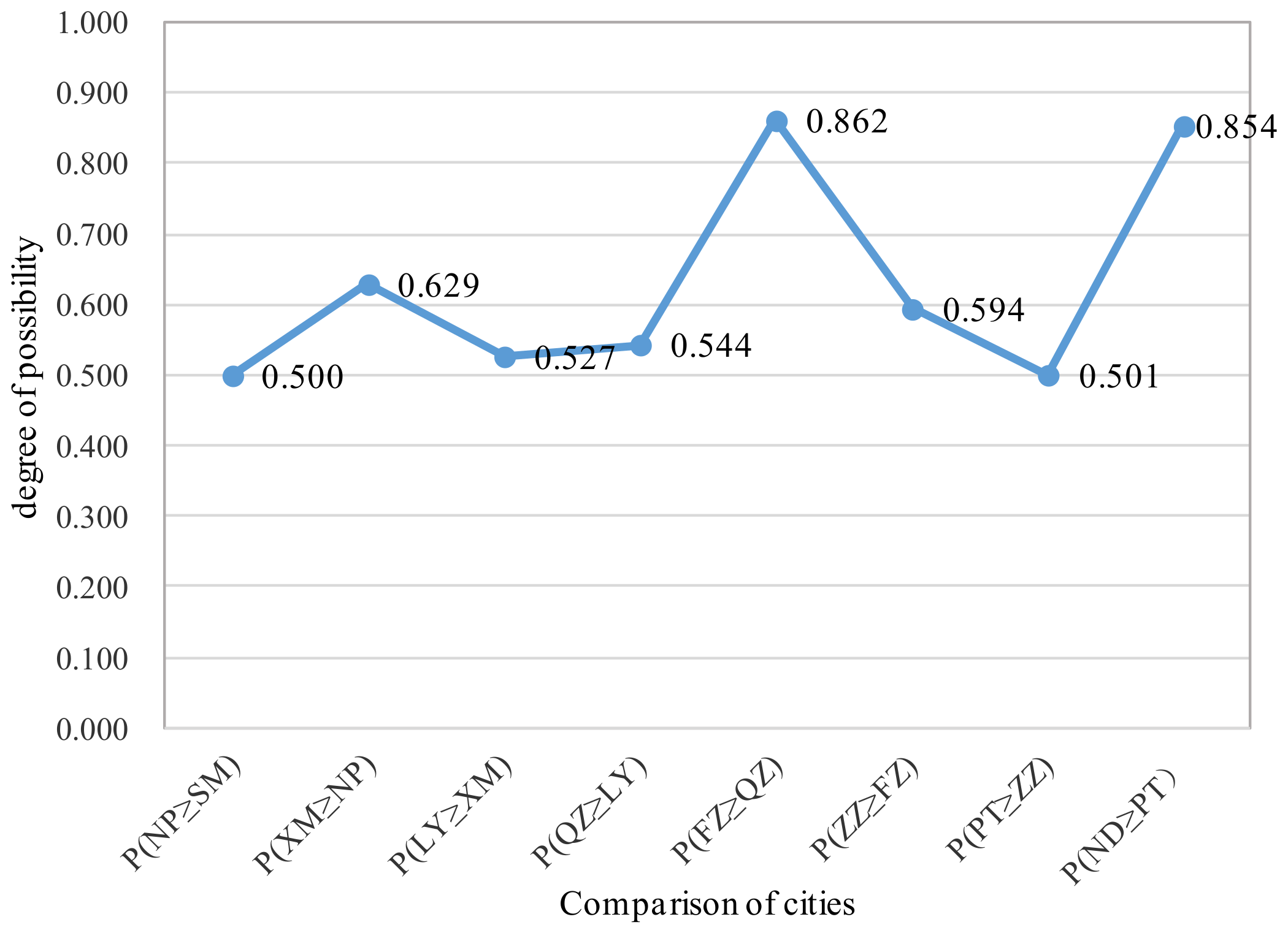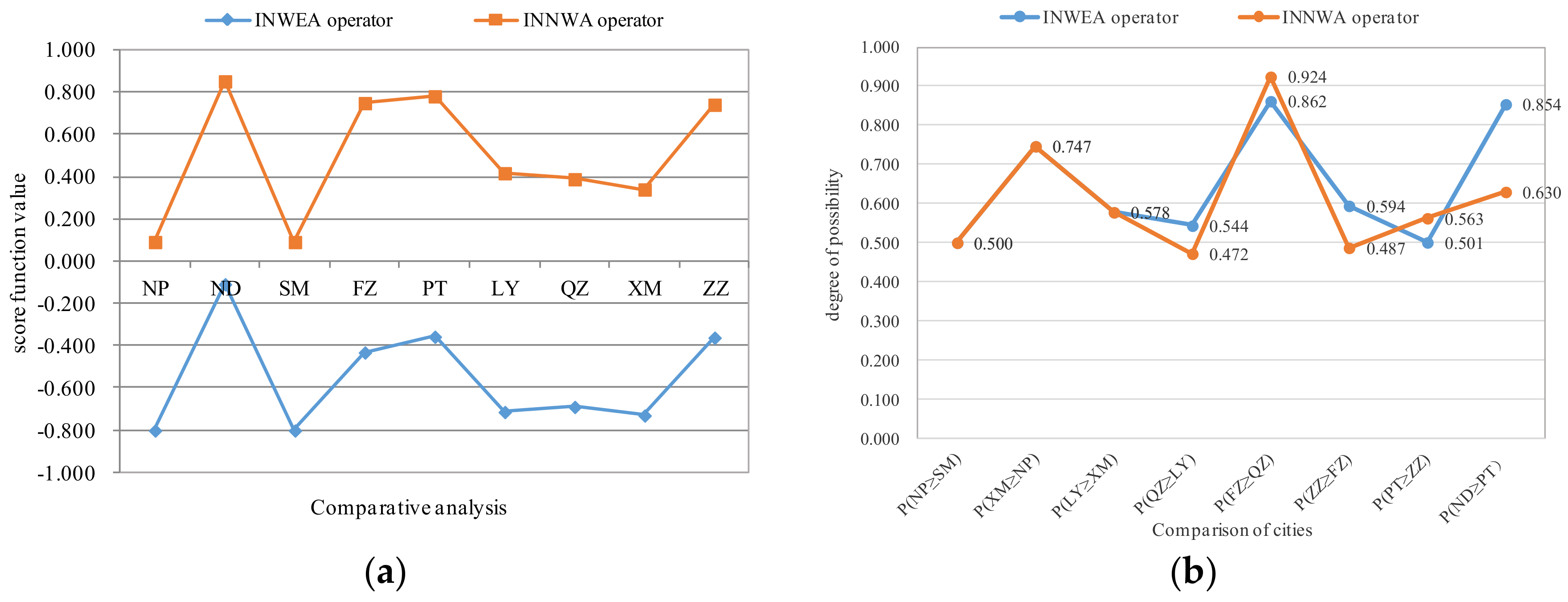1. Introduction
Natural hazards attract worldwide attention. Typhoons are one of the main natural hazards in the world. When a typhoon makes landfall, the impacted coastal areas experience torrential rain, strong winds, storm surges, and other weather-related disasters [
1]. Typhoons can cause extremely serious harm, frequently generating heavy economic losses and personnel casualty [
2]. In the last 50 years, economic damage from typhoon disasters around the coastal regions of China has increased dramatically. The Yearbook of Tropical Cyclones in China shows that from 2000 to 2014, on average, typhoon disasters caused economic losses of 45.784 billion yuan (RMB), 244 deaths, and affected 37.77 million people per year [
3]. Effective evaluation of typhoon disasters can improve the typhoon disaster management efficacy, preventing or reducing disaster loss. Furthermore, precise evaluation of typhoon disasters is critical to the timely allocation and delivery of aid and materials to the disaster area. Therefore, in-depth studies of typhoon disaster evaluation are of great value.
The evaluation of typhoon disasters is a popular research topic in disaster management. Researchers have made contributions to this topic from several different perspectives [
1]. Wang et al. [
4] proposed a typhoon disaster evaluation model based on an econometric and input-output joint model to evaluate the direct and indirect economic loss caused by typhoon disasters for related industrial departments. Zhang et al. [
5] proposed a typhoon disaster evaluation model for the rubber plantations of Hainan Island which is based on extension theory. Lou et al. [
6] adopted a back-propagation neural network method to evaluate typhoon disasters, and a real case in Zhejiang Province of China was studied in detail. Lu et al. [
7] used the multi-dimensional linear dependence model to evaluate typhoon disaster losses in China. Yu et al. [
1] and Lin [
8] asserted that establishing a decision support system is crucial to improving data analysis capabilities for decision makers.
Since the influencing factors of the typhoon disasters are completely hard to describe accurately, the typhoon disasters may include economic loss and environmental damage. Taking economic loss for example, it includes many aspects such as the building’s collapse, the number and extent of damage to housing, and the affected local economic conditions [
1]. Therefore, it is impossible to describe the economic loss precisely because the estimation is based on incomplete and indeterminate data. Therefore, fuzzy set (FS) and intuitionistic fuzzy set (IFS) have been used for typhoon disaster assessment in recent years. Li et al. [
9] proposed evaluating typhoon disasters with a method that applied an extension of the Technique for Order of Preference by Similarity to Ideal Solution (TOPSIS) method with intuitionistic fuzzy theory. Ma [
10] proposed a fuzzy synthetic evaluation model for typhoon disasters. Chen et al. [
11] provided an evaluation model based on a discrete Hopfield neural network. Yu et al. [
1] studied typhoon disaster evaluation in Zhejiang Province, China, using new generalized intuitionistic fuzzy aggregation operators. He [
12] proposed a typhoon disaster assessment method based on Dombi hesitant fuzzy information aggregation operators. However, this review reveals that the application of the neutrosophic sets theory in typhoon disaster assessment has yet to be examined. We believe that neutrosophic sets (NSs) offer a powerful technique to enhance typhoon disaster assessment.
Neutrosophic sets can express and handle incomplete, indeterminant, and inconsistent information. NSs were originally defined by Smarandache [
13,
14], who added an independent indeterminacy-membership on the basis of IFS. Neutrosophic sets are a generalization of set theories including the classic set, the fuzzy set [
15] and the intuitionistic fuzzy set [
16]. Neutrosophic sets are characterized by a truth-membership function (T), an indeterminacy-function (I), and a falsity-membership function (F). This theory is very important in many application areas because indeterminacy is quantified explicitly and the three primary functions are all independent. Since Smarandache’s initial proposal of NSs in 1998, the concept has attracted broad attention and achieved several successful implementations. For example, Wang et al. [
17] proposed single-valued neutrosophic sets (SVNSs), a type of NS. Ye [
18] introduced simplified neutrosophic sets (SNSs) and defined the operational laws of SNSs, as well as some aggregation operators. Wang et al. [
19] and Peng et al. [
20] defined multi-valued neutrosophic sets and the multi-valued neutrosophic number, as well as proposing the application of the TODIM (a Portuguese acronym of interactive and multi-criteria decision making) method in a multi-valued neutrosophic number environment. Wang et al. [
21] proposed interval neutrosophic sets (INSs) along with their set-theoretic operators and Zhang et al. [
22] proposed an improved weighted correlation coefficient measure for INSs for use in multi-criteria decision making. Ye [
23] offered neutrosophic hesitant fuzzy sets with single-valued neutrosophic sets. Tian et al. [
24] defined simplified neutrosophic linguistic sets, which combine the concepts of simplified neutrosophic sets and linguistic term sets, and have enabled great progress in describing linguistic information. Biswas [
25] and Ye [
26] defined the trapezoidal fuzzy neutrosophic number, and applied it to multi-criteria decision making. Deli [
27] defined the interval valued neutrosophic soft set (ivn-soft set), which is a combination of an interval valued neutrosophic set and a soft set, and then applied the concept as a decision making method. Broumi et al. [
28,
29,
30] combined the neutrosophic sets and graph theory to introduce various types of neutrosophic graphs.
When Smarandache proposed the concept of NSs [
13], he also introduced some basic NS operations rules. Ye [
16] defined some basic operations of simplified neutrosophic sets. Wang et al. [
21] defined some basic operations of interval neutrosophic sets, including “containment”, “complement”, “intersection”, “union”, “difference”, “addition”, “Scalar multiplication” and “Scalar division”. Based on these operations, Liu et al. [
31] proposed a simplified neutrosophic correlated averaging (SNCA) operator and a simplified neutrosophic correlated geometric (SNCG) operator for multiple attribute group decision making. Ye [
32] and Zhang et al. [
33] introduced interval neutrosophic number ordered weighted aggregation operators, the interval neutrosophic number weighted averaging (INNWA) operator, and the interval neutrosophic number weighted geometric (INNWG) operator for multi-criteria decision making. Liu et al. [
34] proposed a single-valued neutrosophic normalized weighted Bonferroni mean (SVNNWBM) operator and analyzed its properties. Ye [
35] proposed interval neutrosophic uncertain linguistic variables, and further proposed the interval neutrosophic uncertain linguistic weighted arithmetic averaging (INULWAA) and the interval neutrosophic uncertain linguistic weighted arithmetic averaging (INULWGA) operator. Peng et al. [
36] introduced multi-valued neutrosophic sets (MVNSs) and proposed the multi-valued neutrosophic power weighted average (MVNPWA) operator and the multi-valued neutrosophic power weighted geometric (MVNPWG) operator. A trapezoidal neutrosophic number weighted arithmetic averaging (TNNWAA) operator and a trapezoidal neutrosophic number weighted geometric averaging (TNNWGA) operator have also been proposed and applied to multiple attribute decision making (MADM) with trapezoidal neutrosophic numbers [
26]. Tan et al. [
37] proposed the trapezoidal fuzzy neutrosophic number ordered weighted arithmetic averaging (TFNNOWAA) operator and the trapezoidal fuzzy neutrosophic number hybrid weighted arithmetic averaging (TFNNHWAA) operator for multiple attribute group decision making. Sahin [
38] proposed generalized prioritized weighted aggregation operators, including the normal neutrosophic generalized prioritized weighted averaging (NNGPWA) operator and the normal neutrosophic generalized prioritized weighted geometric (NNGPWG) operator for normal neutrosophic multiple attribute decision making.
As the study of the NS theory has expanded in both depth and scope, effective aggregation and handling of neutrosophic number information have become increasingly imperative. In response, many techniques for aggregating neutrosophic number information have been developed [
18,
26,
31,
32,
33,
34,
35,
36,
37,
38]. However, an important operational law is lacking, we are unable to handle information aggregation in which the bases are positive real numbers and the exponents are neutrosophic numbers. For example, when decision makers determine the attribute importance under a complex decision environment, the attribute weights are characterized by incompleteness, uncertainty, and inconsistency, while the attribute values are real numbers. In the existing literature about exponential operational laws and exponential aggregation operator, Gou et al. [
39] introduced a new exponential operational law about intuitionistic fuzzy numbers (IFNs), in which the bases are positive real numbers and the exponents are IFNs. Gou et al. [
40] defined exponential operational laws of interval intuitionistic fuzzy numbers (IIFNs), in which the bases are positive real numbers and the exponents are IFNs. Lu et al. [
41] defined new exponential operations of single-valued neutrosophic numbers (NNs), in which the bases are positive real numbers, and the exponents are single-valued NNs. In addition, they also proposed the single-valued neutrosophic weighted exponential aggregation (SVNWEA) operator and the SVNWEA operator-based decision making method. Sahin [
42] proposed two new operational laws in which the bases are positive real numbers and interval numbers, respectively; the exponents in both operational laws are simplified neutrosophic numbers (SNNs), and they introduce the simplified neutrosophic weighted exponential aggregation (SNWEA) operator and the dual simplified neutrosophic weighted exponential aggregation (DSNWEA) operator for multi-criteria decision making.
Unfortunately, to date, there are not enough theoretical and applied researches on the exponential operational laws and exponential aggregation operators of interval neutrosophic numbers [
43]. This is what we need to do. In order to perfect the existing neutrosophic aggregation methods, we further enriched the theoretical research of the exponential operational laws of interval neutrosophic numbers (INNs) and the applied research of the corresponding interval neutrosophic aggregation method based on [
43]. In this paper, we discussed in detail several properties of the exponential operation laws of interval neutrosophic numbers, in which the bases are positive real numbers and the exponents are interval neutrosophic numbers. Then, we investigated in detail several properties of the interval neutrosophic weighted exponential aggregation (INWEA) operator, and applied the operator to aggregate assessment information to obtain comprehensive evaluation value. Additionally, a MADM method based on the INWEA operator is proposed. In the MADM problem, the attribute values in the decision matrix are expressed as positive real numbers and the attribute weights are expressed as INNs. Although traditional aggregation operators of INNs cannot address the above decision problem, the exponential aggregation operators of INNs can effectively resolve this issue.
The remainder of this paper is organized as follows:
Section 2 briefly introduces some basic definitions dealing with NSs, INSs and so on.
Section 3 discusses the exponential operational properties of INSs and INNs in detail. Moreover, this paper investigates in detail the properties of the interval neutrosophic exponential aggregation (INWEA) operator in
Section 4. After that, a MADM method based on the INWEA operator is given in
Section 5.
Section 6 uses a typhoon disaster evaluation example to illustrate the applicability of the exponential operational laws and the information aggregation method proposed in
Section 3. Finally, in
Section 7, the conclusions are drawn.
2. Preliminaries
In this section, we review some basic concepts related to neutrosophic sets, single-valued neutrosophic sets, and interval neutrosophic sets. We will also introduce the operational rules.
Definition 1 [13]. Letbe a space of points (objects), with a generic element in X denoted by x. A neutrosophic set (NS) A in X is characterized by a truth-membership function TA(x), an indeterminacy-membership function IA(x), and a falsity-membership function FA(x). The function TA(x), IA(x) and FA(x) are real standard or nonstandard subsets of, i.e.,, , and. Therefore, the sum of TA(x), IA(x) and FA(x) satisfies the condition.
Definition 2 [21]. Letbe a space of point (objects) with generic elements indenoted by.
An interval neutrosophic set (INS)inis characterized by a truth-membership function, an indeterminacy-membership function, and a falsity-membership function. There are,
,
for each pointin. Thus, an INScan be denoted by Then, the sum of , , and satisfies the condition of .
For convenience, we can use
to represent an interval neutrosophic number (INN) in an INS.
Definition 3 [33]. Letandbe two INNs and. Then, the operational rules are defined as follows:
- 1.
- 2.
- 3.
- 4.
Furthermore, for any three INNs , , and any real numbers then, there are the following properties:
;
;
;
;
;
;
;
.
Definition 4 [44]. Letbe an INN, a score functionof an interval neutrosophic value, based on the truth-membership degree, indeterminacy-membership degree, and falsity-membership degree is defined bywhere.
Definition 5. Letbe an INN. Then an accuracy functionof an interval neutrosophic value, based on the truth-membership degree, indeterminacy-membership degree, and falsity-membership degree is defined bywhere.
Definition 6. Let, andbe two INNs, then the ranking method is defined by
- 1.
If, then;
- 2.
If, and then, then.
Definition 7 [33]. Letbe a collection of INNs, andbe the weight vector of, with, and. Then the interval neutrosophic number weighted averaging (INNWA) operator of dimensionis defined by Definition 8 [33]. Letbe a collection of INNs, andbe the weight vector of, with, and. Then the interval neutrosophic number weighted geometric (INNWG) operator of dimensionis defined by 4. Interval Neutrosophic Weighted Exponential Aggregation (INWEA) Operator
Aggregation operators have been commonly used to aggregate the evaluation information in decision making. Here, we utilize the INNs rather than real numbers as weight of criterion, which is more comprehensive and reasonable. In this section, we propose an interval neutrosophic weighted exponential aggregation (INWEA) operator. Furthermore, some characteristics of the proposed aggregation operator, such as boundedness and monotonicity are discussed in detail.
Definition 12. Letbe a collection of INNs, andbe the collection of real numbers, and let INWEA:. IfThen the function INWEA is called an interval neutrosophic weighted exponential aggregation (INWEA) operator, whereare the exponential weighting vectors of attribute values.
Theorem 6[43]. Letbe a collection of INNs, the aggregated value by using the INWEA operator is also an INN, whereandare the exponential weights of.
Proof. By using mathematical induction, we can prove the Equation (10).
- (1)
- (2)
When
, according to Equation (10) there is the following formula:
When , we have the following results based on the operational rules of Definition 3 and combining (2) and (3).
Therefore, for the above results we determine that Equation (10) holds for any
. Thus, the proof is completed. When
, and
, we can also obtain
and the aggregated value is an INN.
Here, we discuss the relationship between the
operator and other exponential aggregation operators. When
,
and
, the
operator of INNs is equivalent to the
operator of SVNNs [
41].
When
, the
operator of INNs is equivalent to the
operator of IIFNs [
40]. When
,
,
and
, the
operator of INNs is equivalent to the
operator of IFNs [
39]. So the
operator of INNs defined by us is a more generalized representation, and the other exponential aggregation operators of SVNNs, IIFNs and IFNs are special cases.
Theorem 7. The INWEA operator has the following properties:
- (1)
Boundedness: Letbe a collection of INNs, and let,
for,
Then.
Proof. For any
, we have
,
,
,
,
,
.
Let
,
, and
, then based on the score function, where
In what follows, we discuss three cases:
- (I)
If , then holds obviously.
- (II)
If , then there is
. Thus, we can obtain
,
,
,
,
,
. Hence, there is
So we have .
- (III)
If , then there is
. Thus, we can obtain
,
,
,
,
,
. Hence, there is
Hence, we have .
Based on the above three cases, there is .
- (2)
Monotonity: Letandbe two collections of INNs. If, then.
Proof. Let
If , then , , , , , for any . So we have , , , , , .
Hence, there are the following two cases:
- (1)
If , then we can get ;
- (2)
If
, then
Therefore, by the condition , , , , , for any , we can get
, , , , ,
Therefore, .
Based on (1) and (2), there is . □
5. Multiple Attribute Decision Making Method Based on the INWEA Operator
To better understand the new operational law and the new operational aggregation operator, we will address some MADM problems, where the attribute weights will be expressed as INNs, and the attribute values for alternatives are represented as positive real numbers. So, we establish a MADM method.
In MADM problems, let be a discrete set of alternatives, and be the set of attributes. The evaluation values of attribute for alternative is expressed by a positive real number . So, the decision matrix can be given. The INN is represented as the attribute weight of the , here indicates the degree of certainty of the attribute supported by the experts, indicates the degree of uncertainty of the attribute supported by the experts, and indicates the negative degree of the attribute supported by the experts. Then, we can rank the alternatives and obtain the best alternatives based on the given information; the specific steps are as follows:
- Step 1
Utilize the INWEA operator to aggregate the characteristic of the alternative .
- Step 2
Utilize the score function to calculate the scores of the alternatives .
- Step 3
Utilize the scores to rank and select the alternatives , if the two scores and are equal, then we need to calculate the accuracy degrees and of the overall criteria values and , then we rank the alternatives and by using and .
- Step 4
End.







